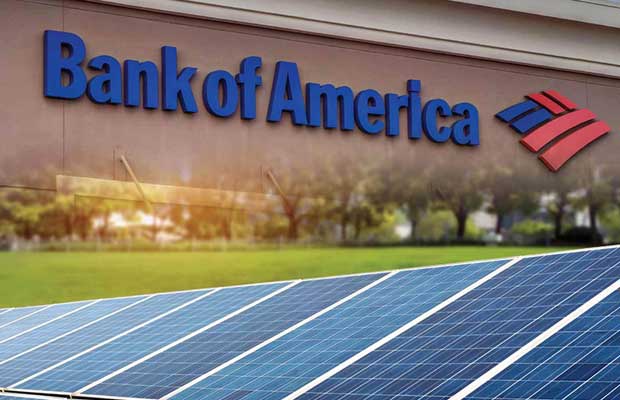Bank of America: Among The Leading Banks When It Comes To Sustainability.
- Scott Case

- Jun 5, 2023
- 4 min read
In an era where environmental sustainability is of paramount importance, leading organizations are making significant strides to reduce their carbon footprint. Bank of America (BofA), one of the world's largest financial institutions, has set a remarkable example by successfully sourcing 100% renewable electricity since 2019 according to their latest ESG Performance Data Summary. This comes after initially making the commitment to source 100% renewable electricity as far back as 2016. Knowing that they reached their goal in only three years, this achievement highlights their commitment to combating climate change and fostering a sustainable future. This commitment to sustainability is rooted in their initial desire to join the UN’s GISD Alliance in 2019.
CEO Bryan Moynihan said
“we can ensure sufficient private-sector capital is available to address societal priorities,” and that “public companies align their business models and focus on the Sustainable Development Goals that are most relevant to their business.” Along the way, the bank has continued to reinforce its position that sustainability is an important part of its business fabric with a number of firsts in 2020: releasing their first TCFD report; joining RE100; becoming a founding partner of Rocky Mountain Institute’s Center for Climate-Aligned Finance; and joining the Partnership for Carbon Accounting Financials (PCAF) as a core member. As a result of these efforts, 100% renewable electricity sourcing covers a staggering 1.7 million MWh of Bank of America’s electricity.
The BofA Way: Methods Employed to Achieve Sustainability Goals
To meet its renewable electricity procurement goals, BofA utilized a multi-faceted approach. A large focus has been on a combination of renewable energy tools such as power purchase agreements (PPAs), on-site renewable energy generation, investments in community-based renewable projects, and renewable energy certificates (RECs).
According to Andrew Plepler, BofA's Global Head of Environmental, Social and Governance (ESG), “by implementing new and innovative renewable energy structures, we demonstrate our strong commitment to carbon neutrality, secure stable renewable electricity at a favorable cost, and provide an economic and environmental benefit to the communities where we work and live."
The yield from these approaches has been very fruitful. First, in 2020, Bank of America signed 10 agreements to purchase solar electricity for its operations in three states, including North Carolina, home to the company’s headquarters, partnering with Duke Energy and others. In 2022 they partnered with Constellation on a solar power agreement and project-specific renewable energy certificates for a 15-year, 160 MW deal producing enough renewable energy to help power 17% of its global electricity consumption needs. Moynihan has noted that deals like these play an important role, and that “being carbon neutral is core to our $300 billion, 10-year environmental business initiative that is helping finance the transition to a low-carbon future.” This decentralized approach further bolsters BofA’s renewable energy procurement efforts and reduces reliance on the traditional power grid.
However, as with any ambitious endeavor, there are risks involved. Inevitably, BofA will face potential challenges like fluctuations in electricity consumption, the availability of renewable energy sources, regulatory changes, and evolving technologies. Nevertheless, it’s clear that the bank remains steadfast in its commitment to navigating these risks and ensuring a sustainable energy future.
Opportunities to Improve: The Impact of RECs with Additionality on BofA's Progress
While BofA's renewable electricity procurement strategy has been successful in reducing its carbon footprint and procuring 100% renewable electricity, there’s an opportunity to further improve its impact by including RECs with additionality in its strategy. RECs with additionality are certificates or credits representing the environmental attributes of renewable energy not unlike any other unbundled REC. However, RECs with additionality are also forward commitments, at a fixed price for a fixed term, directly subsidizing the development of new renewable energy projects before their commercial operation date.
By including RECs with additionality in its strategy, BofA could take its leading role in corporate sustainability to another level. First, procuring RECs with additionality would greatly increase BofA’s contribution to the speed at which the grid can change to renewable energy. Second, since BofA continues to use unbundled RECs without additionality in its strategy, switching to RECs with additionality would allow the company to make a more impactful marketing claim for sustainability purposes. Third, procuring RECs with additionality would also mitigate costs over time associated with continued renewable energy procurement using RECs without additionality.
Finally, RECs with additionality could provide scale to BofA’s emission reduction strategies needed to cover increased consumption of megawatt hours (MWh) of electricity as their business continues to grow. By all accounts, both the unbundled REC and the PPA markets are expected to see continuing price increases driven by demand. Instead of constantly enduring the lengthy PPA/VPPA process along with either their long term commitments or market risk, procuring RECs with additionality would be simple, straightforward and geography agnostic.
While BofA has made significant progress in reducing its carbon footprint and promoting sustainability through its renewable electricity procurement strategy, including RECs with additionality in its strategy could further improve its impact and further accelerate the world’s transition to a low-carbon economy.









Comments